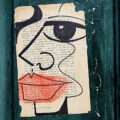Continual Critique: After the After of Ecology

eco language reader
Brenda Iijima, ed.
Softcover, $19.95
Nightboat Books, 2010
The texts included in The Eco Language Reader (edited by Brenda Iijima; Nightboat Books, 2010) are not attempts at one sort or another of a genre of “ecopoetics.” They remain usefully outside any definition. What’s given instead is an array of essays and interviews attending to poetics-at-large and the possibilities that a shared concern gathers round itself. If you are familiar with the work of Jonathan Skinner, Jed Rasula, Laura Elrick, Jack Collom, Jill Magi, Leslie Scalapino—or are interested in, say, concerns shared by Charles Olson and Lorine Niedecker—it is likely that you will be happy to discover what is said here and to be exposed to like-minded writers with whom you may not be as familiar. But even the unfamiliar can take heart in the broad range of texts. As editor Brenda Iijima puts it in her interview with Tyrone Williams, the common concern of all these pieces is “contemporary writing that gets called poetry,” a definition that need not disregard most works or writers.
The project began as a call for participants in a panel discussion held for the Segue Reading Series in New York, in January 2006. Its premise was the question, “How can poetry engage with a global ecosystem under duress?” This gives some insight into the origins of the collection, but not into the context for the varied responses that Iijima has gathered. Not all participants focus solely on the global ecosystem, either in terms of geographical expanse or a specific ecology of plants, wildlife, and/or the earth itself. There is also the presence in these pieces of “the social,” perceived as both a human-centered and a human-developed ecosystem of its own, which is also under duress. These persuasive and timely texts venture into territory that poets of the past usually bent towards self-serving ends. But in Iijima’s collection, rather than utilizing concern for environmental situations as an occasion for writing with intended results, the texts remain open to possibilities of the immediate situation and where it might lead. Nature may be at the center of these writings, but it is so as a necessity of the current occasion rather than the cause.
Iijima “see[s] these essays acting as a think-tank forever.” Participants respond to the question of ecopoetics engagingly, in ways that leave the texts open to shifts in the conditions to which they’re responding. By dint of their unstable subject, these pieces are inherently acts-in-progress. They continue beyond the confines of the printed page, as Iijima says, “hopefully opening up and furthering intense discussions around the issues presented.” Of central concern is the question of what it means, as a poet confronting an ecology in distress, to also have a Language-Project? And in these specific terms, more vitally, what does it mean to have an Eco-Language-Project? This is neither a beginning of something, nor the summing up of a discussion or a movement, but a necessary conversation spurred by the specifics of current conditions. Engaging questions such as, “How will we continue to read and write ecological engagement?” insistently point toward that very situation, without seeking to erect limitations around it.
One possibility for how such a project may be framed is offered by Leslie Scalapino’s remark, “Seeing at the moment of, or at the time of, writing, what difference does one’s living make? What difference does one’s living make in ‘that’ space, and in relation to spaces all existing at once there?” The writers and thinkers here engage language while, all around them, that same language, by its very structure and referential nature, is a force for domination and destruction of the various natural systems within which life exists. Poets are in a unique position to critique that situation. They are intimate with the force that language yields, not only in regards to realms beyond the window, but also to interior social environments. Poets as language-bearers have a vital role to play in the engagement and exchange of ideas, as Leslie Scalapino quips: “I don’t find the relation of language to so-called ‘political’ events to be illogical.”
Jill Magi asserts, “an ecopoetics potentially operates in an oppositional mode, creating performances of language that point out literature’s role in perpetuating power, and its role in erasure.” Such “writings,” she continues, “resist commodification, defying traditional measures of effective communication, yet not always embracing environmentalism uncritically.” The commonly shared thrust among these writings is one of potential: the potential of writing to confront dilemmas of relation as they arise. In Jack Collom’s words, “I just wanna maintain the energy of having options.”
Confronted by writing, in writing, nature does not have a voice of its own besides that which is granted, imposed, or allowed. Thus, writing manipulates without heeding matters beyond the concerns of the human correspondents, who give voice on nature’s behalf. As Collom pointedly suggests, “I propose that even when nature is complimented (and at the same time poised beyond the tame glow of patronization), nature writings usually bespeak the assumption that nature is secondary. I further propose that even in writings more plainly sophisticated… say, like those of Robert Frost and Mary Oliver … the principal energy seems presented with undue emphasis on intellectual control of the writings.”
The effort, then, must be to disengage from speaking of and for that which poets do not understand. It undermines the possiblities that come when writing is not planned in advance, and when the form and meaning of such writing opens to other, un-conceived possibilities. Marcella Durand sees such openness in a poem of Collom’s, where “one might look at how the structure of the poem follows the structure of the wave, in that movement at the beginning of the poem (‘the humps remain while their substance / moves on by’) forever shadows the end, while yet the poem retains an exploratory movement—there is a sense of the poem taking form as it is written. The poet throws an investigative rock and continues with words—the spaces between poet and word and creek are truly active, creative.” The writing of the poem finds itself as the subject matter unveils itself, alive in the momentary act of being.
Tyrone Williams alternatively declares that ecopoetics “is a necessary adjunct to the overall critique of both late capitalism and fundamentalist Marxism,” in which the poetry community seemingly has a part to play in “an important mode of socioeconomics and cultural critique, not least against a ‘nature’ poetics apparently resistant to extinction.” If this collection makes any cogent claim, it is that these poets are all, in one way or another, part of an anti-establishment approach towards any categorical possession of concerns over nature or the environment. They resist the co-option of this debate. As Jill Magi states: “I would have to take ecopoetics to be a continued critique of ecology, nature writing, and environmentalism — mainstream environmentalism: a movement which has largely ignored race, class, and labor.” Beneath this collection runs a deep resistance against any sense of privileged knowledge. Evelyn Reilly sees “that ecopoetics must be a matter of finding formal strategies that effect a larger paradigm shift and that actually participate in the task of abolishing the aesthetic use of nature as mirror for human narcissism.” Throughout, it is the same call: paths must be sought that hopefully will not be co-opted allowing further entitlement over damaged landscapes and living systems.
Yet even within communities so committed to alternate paths, a wary unease remains. Certain questions about power and control will never be dismissed: to what ends are writings directed? Whose priority is being served? Importantly, to whom are you being, or encompassing others to be, subservient? These questions are reflected and tested by how we choose engage or disengage from current social dilemmas. As Laura Elrick notes, we have recently lived through a period of time that has “experienced decreases in democracy at the workplace, decreases in access to healthcare and to quality public education, a slow but steady corporatization of the media, and an upsurge in covert military operations.” These cultural and social changes are negatively felt across numerous divides as impositions that are the shared result of failed cultural behavior. What poets bring to the discussion, if they do enter into it, immediately situates their own writing within a community response, but it remains their own responsibility to hold the work itself accountable. Merely pointing out the spectacle of cultural loss is not to seek constructive alternatives.
Once one acknowledges, as Elrick continues, “concurrently, the striking rise in world temperatures, the speed of deforestation, the rate of species extinction, and the air, water, and soil pollution,” then the immediacy of need crying out to address the situation becomes palpable. Elrick is quick to note, however, that one might “question whether the upsurge in the number of young people throwing in their lots with poetry is related to the democratization of literature when everywhere else democracy is shown to be a scam. Is it freedom or a regulation? And for what and for whom?”
But why not allow poetry to provide refuge for those neglected by the system? As Elrick points out, “the brutal extension of the reign of profit into every area of the globe, and not only into physical spaces such as forests, glaciers, and oceans, but also into every facet of social life” has thrown everybody into the juggernaut of these dilemmas. She continues, “recognizing our collective participation in this extension might bring about new ways of engaging in the practice of poetry, a poetics, in short, that points less towards a fetishtic valorization of ‘the text’ as object (form & content) intervene in (and experiment through) the mode of production, circulation, and exchange.” Writing pursuant to these matters may not offer solutions, but it contributes to awareness, to a visceral awareness that transcends statistical measures or counterfactual argument. To this end it is not a lost (even if it be losing) cause. The momentum of common energy only increases as the avid desire to connect with the ideas and thoughts of a wider community grows.
Of course, many more questions are raised than answered. James Sherry asks, “Can we use the analytic tools of arts and sciences interactively for the purposes of a policy of a less invasive approach to global domination?” If the answer is “No,” then other plausible options are perhaps represented (somewhat scarily for the fate of language as an art of communication) by artist Julie Patton’s statement before her images near the center of the book: “Ecocurator s rap another, in part my own, meta spherically breaking some kind of tree template fur which to bend meaning. ‘Nuff said.” It’s an open question as to just how many readers are comfortable with this sort of hip, drawling response, which skirts elementary theory-based conceptual speech. Jonathan Skinner’s breezy remark, “I love a good look at a Hooded Messanger: one far-out bird” is likely to be a more popular approach. But there’s purpose and community served by each of them. The Eco Language Readerprovides a bevy of similar variations on writing and digging into the hooks and crooks of “nature” via language, whatever and wherever may be your ’hood.
“Poetries are social documents that express relationships within ecosystems. I like to think this process (poetry) recalibrates the social—how we function dynamically in space, in time, with each other—communally, communicational,” Iijima writes. This is an encouragement worth facing and writing toward. Iijima and crew bring various elements of an overtired conversation back to life—of language and poetry, of ethics and poetics, of the role of the poet in society—in refreshing ways and often on new terms. There is no power-grabbing or assertion of authority: community is sought. It is an engaging call to work, playful and never boring, with tireless energy. These necessary texts await further company with bemused glee.
About Patrick Dunagan
Patrick James Dunagan lives in San Francisco and works in Gleeson library at USF. His latest book is There Are People Who Think That Painter's Shouldn't Talk: A GUSTONBOOK (Post Apollo, 2011). Other writings appear (or expected) in 1913, A Journal of Forms, Amerarcana, Greetings, House Organ, Lightning'd Press House Mag, and elsewhere.





